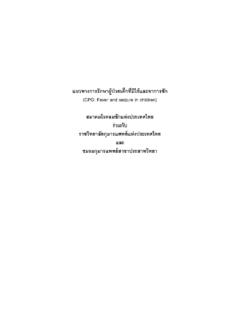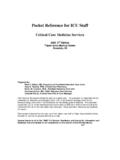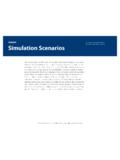Transcription of EPILEPSY - WHO
1 EPILEPSY : A manual for Medical and Clinical Officers in AfricaInternational Bureau for EpilepsyWorld HealthOrganizationInternational League Against EpilepsyAmanual for Medicaland Clinical Officersin AfricaEPILEPSYWHO/MSD/ AfricaCov 25/11/02 15:38 Page 1 EpilepsyA manual forMedical and Clinical OfficersIn Dekker, Revised editionWorld health OrganizationGeneva2002 Revised edition 2002 SecretariatILAE/IBE/WHO Global Campaign Against EpilepsyAchterweg 5, 2103 SWHeemstede, the NetherlandsFirst edition Dekker, 1990 Second edition Dekker, 1994 Reprint Epicadec 1998 world health organization 2002 All rights reserved. Publications of the world health organization can be obtained from Marketing and Dissemination, world health organization , 20 Avenue Appia, 1211 Geneva 27, Switzerland (tel: +41 22 791 2476; fax: +41 22 791 4857;email: Requests for permission to reproduce or translate WHO publications whether for sale or fornoncommercial distribution should be addressed to Publications, at the above address (fax: +41 22 791 4806; designations employed and the presentation of the material in this publication do not imply the expression of anyopinion whatsoever on the part of the world health organization concerning the legal status of any country, territory, city orarea or of its authorities, or concerning the delimitation of its frontiers or boundaries.))
2 Dotted lines on maps representapproximate border lines for which there may not yet be full mention of specific companies or of certain manufacturers products does not imply that they are endorsed orrecommended by the world health organization in preference to others of a similar nature that are not mentioned. Errorsand omissions excepted, the names of proprietary products are distinguished by initial capital world health organization does not warrant that the information contained in this publication is complete and correctand shall not be liable for any damages incurred as a result of its named author and editors alone are responsible for the views expressed in this layout: Harry Meinardi and Annemarie HartingDesign: Tushita Graphic Vision, Tushita Bosonet & Carine MottazCover photo: WHO. H. AnendenPrinted in FranceiiiCONTENTSvvi11344477111515151517 171819282931323239394142434546474750 ContentsPreface and acknowledgements to the revised edition 2002 Introduction and acknowledgements to the first editionABBREVIATIONSGLOSSARYCHAPTERS1.
3 Definitions2. EpidemiologyPrevalenceIncidence3. CausesCauses of a seizureCauses of epilepsy4. Contributory factorsGenetic factorsEffects of brain maturationOther precipitating of a seizureCharacteristics of a seizureInternational classification of epileptic seizuresWhich seizures do we see in daily practiceStatus of epilepsiesLocalization-related epilepsiesGeneralized , examination and investigationsMedical historySocial historyExaminationInvestigationsPsycholo gical to be distinguished from epilepsySyncope (fainting)Psychogenic non-epileptic seizuresOther disordersivCONTENTS9. Conditions co-existing with epilepsyCerebral palsyMental retardationPsychiatric problemsBehaviour disordersLearning during a seizureDrug therapyMonitoring serum levels of AEDsDietSurgeryManagement of status epilepticusPromoting convulsionsManagement of febrile Social aspectsFire EPILEPSY clinicsFirst visitThe EPILEPSY Aide Registration cards and record keepingMedicines and costsAPPENDICESA ppendix A: Review of the epilepsies and their treatmentaccording to age linked groupsAppendix B: Antiepileptic Drugs (AEDs)PhenobarbitonePhenytoinCarbamazepi neValproic AcidEthosuximideClonazepamDiazepamAppend ix C: Head circumference graphsAppendix D.
4 Record cardsBIBLIOGRAPHYINDEXUSEFUL ADDRESSES5353535555565657575865656566686 9707274767779797980828594949698991011021 03106108113115122vPREFACE AND ACKNOWLEDGEMENTSP reface and acknowledgements tothe revised edition 2002 The initiative of the International League Against EPILEPSY (ILAE),the International Bureau for EPILEPSY (IBE) and the world HealthOrganisation (WHO) to start a Global Campaign Against Epilepsykindled the search for a textbook, in order to provide medical andclinical officers working in rural areas in Anglophone Africa withsufficient and sound background choice fell on a manual, written by the late Nelly Dekker, aDutch expatriate doctor who had worked in Ethiopia and Kenya formany years. She was a co-founder of the Kenyan Association for theWelfare of Epileptics, an initiative of Caroline Pickering, mother of achild with EPILEPSY . After Dr Dekker s untimely death in 1995 herhusband released the copyright of the book to allow for non-profitdistribution in the developing order to update the book and adapt it for use in all of AnglophoneAfrica the Secretariat of the Global Campaign Against Epilepsyappointed an editorial committee with expertise in Africa, Americaand Europe.
5 Members of the committee were Bryan Kies (SouthAfrica), Cecilia Bartels (Kenya), Gretchen Birbeck (USA/Zambia), HarryMeinardi (Netherlands), Jens Mielke (Zimbabwe), and Zenebe GedlieDamtie (Ethiopia). As the original was in English the editorial committeewas Anglophone, however, a similar book will be made available inFrench and in committee was charged to refrain from rewriting the book orproduce a completely new text, yet to ensure its accordance withpresent day expert knowledge and opinions. They gratefullyacknowledge helpful suggestions and comments from the secretariat ofthe Global Campaign Against EPILEPSY (Pete Engel, Hanneke de Boerand Leonid Prilipko), and the regional advisor for mental health WHO/AFRO Custodia project would have been much more costly if the editors had notbeen assisted by the staff of the printer-division of PASWERK, a shelteredworkshop also employing people with EPILEPSY , CRUQUIUS, TheNetherlands.
6 In particular the expert help of Ms. Jacky van Ruitenassured that hurdles and pitfalls in the conversion and adaptation ofthe original text to its present printable form were final responsibility for its contents remains with the realise that some of their choices are open to criticism but theyare confident that an evaluation in five years time whether the bookhas served its purpose will be EDITION INTRODUCTION AND ACKNOWLEDGEMENTSI ntroduction andacknowledgementsto the first editionThe Kenya Association for the Welfare of Epileptics (KAWE) wasestablished in 1982. Through its activities, which include clinics andpublic education in the form of film and printed materials, people havebeen made aware that EPILEPSY is a medical condition and that it can,therefore, be treated medically and be controlled. As a result, thenumber of patients with EPILEPSY seeking treatment is is a major public health problem in this reason a manual has been prepared to help those people(medical officers, clinical officers and nurses)
7 Who are responsible forthe primary health care of these patients and who may be working inthe rural early treatment of convulsions and of EPILEPSY is very important,it is essential to start correct treatment in order to be able to start this treatment, the doctor or clinicalofficer needs to know the causes of the seizures and EPILEPSY , whattype of seizure and EPILEPSY the patient has, and which drug should is emphasized that not all seizures are a form of EPILEPSY andtherefore it is necessary to know the different causes of seizures inorder to be able to distinguish those not due to EPILEPSY and to treatthem adequately. Knowing the cause of EPILEPSY will also help patientsovercome their superstitions about the different types of seizures and their general classification of theepilepsies are given in Chapters 7 and 8 [Chapters 5 and 6 in the 2002edition], while a more detailed discussion of the epilepsies and theepileptic syndromes is in Appendix A.
8 In this manual the patterns of the EEG findings in differentepilepsies are not illustrated or discussed as an EEG can only be donein the drugs used in treating patients with EPILEPSY may be dispensedfor years, it is necessary to know a few facts about these the side-effects and interactions with other drugs are notalways understood or predictable, these actions must be known byeveryone dealing with these drugs. General information about theseactions is given, while the individual anticonvulsants are discussed indetail in Appendix B. However, the therapeutic blood levels of thevarious medicines are not mentioned as they are not routinelydetermined in EDITION INTRODUCTION AND ACKNOWLEDGEMENTST hanks are due to Professor H. Meinardi (Instituut voor Epilepsiebestrijding, Heemstede), for his continuous advice and comments, andmy colleagues Oei and Doelman (EpilepsiecentrumKempenhaeghe, Heeze) in the Netherlands, for their help and forproviding the necessary also thank the following colleagues in Kenya who read themanuscript and made valuable comments: Professor R.
9 Ruberti, , P. Muthiga, C. Forbes, G. Rietkerk, D. Franssens, H. Wouters,M. Gajjar (psychologist), W. Nieuwstraten, and thanks are due to Dr J. Moore-Webster who was indefatigablein helping to formulate the contents in as concise a manner as possibleand to Drs Miyanji and Stanfield who helped make the informationreadable and arranged in a logical A. Melvin and Mrs. C. Pickering are thanked for patient typingand retyping, Mrs C. Agola for editing and Mr Backhurst , we are grateful to Christelijke Vereniging voor de Verplegingvan Lijders aan Epilepsie, Heemstede, The Netherlands, for assistancein printing this Dekker, Nairobi, drugAIDSA cquired immune deficiency syndromeEEGE lectro-encephalogramGTCS Generalized tonic-clonic seizureHHEH emiconvulsions-hemiplegia-epilepsyHIVH uman immunodeficiency virusILAEI nternational League Against EpilepsyKAWE The Kenya Association for the Welfare of EpilepticsREMR apid eye movementSSPES ubacute sclerosing pan-encephalitisGlossaryAbsence absent; not being there.
10 Name given to seizures that only causea brief lapse of consciousnessAnoxia lack of oxygen reaching the tissues of the bodyAnticonvulsant agent preventing or arresting a convulsionAntiepileptic drug a term often preferred instead of anticonvulsantAphasia loss or impairment of the power to use words due to a lesion inthe brainAsphyxia lack of oxygen or excess of carbon dioxide in the body, usuallycaused by interruption of breathingAstatic not able to standAtaxia loss or impairment of muscular coordinationAtonic without (muscle) tone (used interchangeably with astatic)Auditory relating to the sense of hearingAutomatism more or less coordinated movements independent of consciouscontrolAutonomic relating to that part of the vertebrate nervous system thatregulates involuntary action ( , intestines, heart, glands)Calcification the process by which tissue becomes hardened by depositsof calcium, or the calcified structureChoreo-athetosis constantly occurring slow, involuntary abnormalmovementsClonic alternatingly flexing and stretching of limbsCryptogenic symptomatic, but whose cause is hidden or occultD j vu an illusion in which a new situation is incorrectly perceived asbeing a repetition of a previous situationDementia organic deterioration of mental or intellectual facultiesGLOSSARY2 Diplegia paralysis of corresponding parts on both sides of the bodyDyskinetic disordered movementsDystonic disordered muscle toneDysphasia words are distorted or used incomprehensiblyFocus an area in the brain that is the starting point of a partial (asopposed to generalized)














